

Elvis tries out his brand new "Burning Love" suit in Las Vegas on January 16, 1972 (ten days before he opened his sixth month-long season there). He posed in a variety of martial arts stances, executing various punches -- I guess it was as good a way as any to test the suit's limits.


Low block and high block, in a suit that coast several thousand dollars (in 1973, Elvis donated this suit to a charity, which then sold it for many thousands of dollars)...
From Variety (2/9/72): "His format is taut, he pays attention to his songs and audience, the karate exercises are quite vigorous and his ringside kissing technique is like a dozen midway attractions rolled into one."

Dropping into the split during an extended stage performance of "Suspicious Minds," at the evening show of April 8, 1972, in Knoxville, TN. Elvis would stretch one leg and then move over, still low, to stretch the other, during a lull in the otherwise frenetic song.

This shot from the April 16, 1972 afternoon show in Jacksonville, FL, nicely captures the stage presence of Elvis circa 1972 (as nicely as a still image could ever do justice to such a dynamic performer). This picture of Elvis, typically in his forward horse stance, was seen by millions who rushed out to buy the live LP recorded during one of Elvis' June shows at New York's Madison Square Garden, catapulting yet another LP instantly to gold status.

The forward horse ("bow and arrow") stance is a staple in all Chinese and Chinese-influenced martial arts, and was a dramatic staple of Elvis' physical repertoire during these concert years. This photo was probably taken during the April 18, 1972 show in San Antonio, TX.

Another shot that's probably from the same date -- when Elvis began wearing bejeweled capes on stage in late 1971 he wore them for the first few songs and then put them back on for the last few or the last one. Here, Elvis has sweated his hard-working way through an entire concert in a hot stadium, dressed in a heavy wool gaberdine jumpsuit, and has donned his equally-heavy red-lined cape (each suit has its own matching cape) for the dramatic closing of the show, as the massed backing vocalists hold the final note of his closer, "Can't Help Falling In Love."
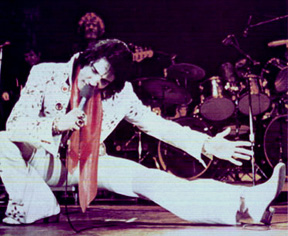
Stretching the kinks out during "Suspicious Minds," on tour in April, 1972 (probably April 18, in San Antonio, TX). Parts of this tour were filmed for the 1972 documentary, "Elvis On Tour," which went on to win a Golden Globe.


A bit of action from the excellent afternoon show of June 10, 1972, in New York's Madison Square Garden. The Garden appearances (one show on June 9, which opened his June tour, two on June 10, and one on June 11) were a big deal in the media because Elvis was said to be the only big musical star who'd made it big without ever playing New York. Of course, some of the 1956 TV shows that Elvis did were shot in New York (and most of his 1956 session material recorded there at RCA's studio), but he'd never played a truly live event there prior to 1972. Elvis even gave a rare press conference before the first show, showing himself to be in fine form and the master of the amusing and entertaining but little-revealing interview (the Beatles were basically his protegees in that skill). Among celebrities in the Garden audiences were fellow musicians like John Lennon, George Harrison, and Paul Simon. The evening show from June 10 was released as an RCA album before the tour had even ended -- basically an exercise in speed to see if they could pump out a live album of the upcoming Hawaiian satellite show quickly enough -- and it promptly went gold. The afternoon show was more recently released by RCA-BMG as "An Afternoon in the Garden" and probably covers a slightly more diverse and representative musical ground than the previous release.

Elvis hits a martial pose on the June, 1972 tour. This photo was probably taken during Elvis' evening performance at Madison Square Garden on June 10, the show immortalized on the best-selling 1972 LP.
From Billboard (6/24/72): "Elvis at the Garden was a stone gas. Nostalgia was but a small part of the celebration. Elvis' voice, always better than the critics had admitted, has become richer and more resonant than before.
From the New York Times (6/18/73): At 9:15 Elvis appeared, materialized, in a white suit of lights, shining with golden appliques, the shirt front slashed to show his chest. Around his shoulders was a cape lined in cloth of gold, its collar faced with scarlet. It was anything you wanted to call it, gaudy, vulgar, magnificent. He looked like a prince from another planet, narrow-eyed, with high Indian cheekbones and a smooth brown skin untouched by his 37 years...He stood there at the end, his arms stretched out, the great gold cloak giving him wings, a champion, the only one in his class."

Thrusting his guitar bayonet-style was kind of a '70s trademark for Elvis (this shot probably from the June, 1972 tour), and incidentally showed off his IKKA Kenpo patch to great effect.

About to unleash a bit of chi for emphasis in Chicago, IL, on June 17, 1972 (afternoon concert). This picture is most likely from the sequence of kicks and punches -- probably part of a kenpo brown -- that Elvis ended "Suspicious Minds" with as the drummer did his best to match his and Elvis' percussion. Elvis started doing these extended karate-endings in late 1971 and did them on and off throughout 1972 (one can be heard on the recently-released official BMG product "An Afternoon in the Garden," which documents one of his June 10, 1972 shows in New York's Madison Square Garden). Photograph by Sean Shaver.

Again probably from the "Suspicious Minds" karate ending, Elvis launches a kick during his afternoon concert in Chicago.
From the Chicago Tribune (6/17/72): "He kissed a few never-to-be-forgotten kisses, tossed a few perspiration soaked scarves, graciously accepted the proffered lingerie. Crouching and karate chopping, he teased the audience into a perfectly controlled, orderly, well behaved hysteria. And to think, his 5th grade teacher called him average."
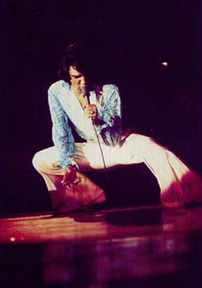
From the summer of 1972 (supposedly from a Tulsa, OK concert on June 20, the June tour's last show), Elvis gets down and takes it to a low crouch. He wore these shirt-and-pants outfits for a few dates on the June tour, and then for most of the first part of the Vegas season that followed, but ripped his pants one too many times during "Polk Salad Annie" and other numbers he moved a lot to, and switched back to jumpsuits full-time. The shirts and pants must have been a lot cooler and more comfortable -- Elvis' jumpsuits were heavy (even heavier for the period from late 1971 to mid-1973 when he added bejeweled capes) and a typical ensemble might weigh something like 40 pounds. Contrary to popular belief, Elvis' jumpsuits were not polyester (they were made of wool gabardine) nor were they decked out with rhinestones (some may have been, but many incorporated real stones, as did his belts and capes, including rubies, sapphires, and diamonds). Photograph by Ed Bonja.

Another shot of Elvis pulling a split during the June 20 show, undoubtedly also by Ed Bonja.

Dropping to one knee, clawing hands shaking with the power of the feeling that pours through Elvis as he sings -- live at the same Wichita show. Photograph by Ed Bonja.

Elvis dropping to a split during "Suspicious Minds" ("I hope this suit don't tear up, baby") during a special added 3 AM show in Las Vegas (September 3, 1972, the day before he closed another phenomenally successful "Elvis Summer Festival" there). Elvis filed for divorce on August 18, midway through his Vegas stint, prompting him to ad lib lines to his stageside female admirers like asking them whether they wanted to get srious, because "I'm free now, you know." Photo by Judy Palmer.
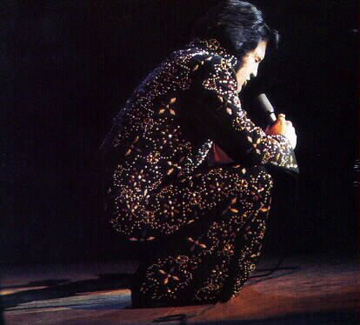
Elvis gets down for his afternoon show of November 18, 1972, in Honolulu, HI. The two shows he gave that day (and the one on the previous day) were excellent, and gave him a preview of the venue in which he'd perform for both satellite-linked and live audiences less than two months later.
From the Los Angeles Herald-Examiner (11/17/72): "Attired in the white, studded jump suit, which has become a trademark, the singer moved about the stage like a dancer, he handled the microphone as if it were a part of him, and his voice seems to get better with each appearance."

Elvis ends a song on the November, 1972 tour.
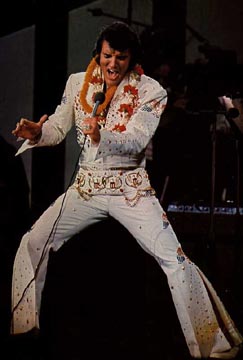
The Aloha from Hawaii television special was beamed live from Honolulu after midnight, local time, on January 14, 1973. About 1.5 billion people are estimated to have tuned in the show, which was more than saw the first moon landing live four years ealier. Aloha was later aired in the US as an edited special with additional songs that Elvis recorded (somehow) after the show, and the double-album it led to became yet another gold record. The broadcast was probably Elvis' crowning achievement -- he was the first and made the biggest impact -- but the down side was that (apart from the world tour that fans had been clamoring for since the 50s) Elvis' personal and professional horizon looked a bit bleak. How could he possibly top this extravaganza? In 1960, after his return from the Army, Elvis rose to the challenge of recapturing his crown. In 1968, he worked himself harder than ever before to prove to himself and the world that he still had what it takes (a transcedent moment preserved as a television special). In 1969 and in to the 70s he proved himself supremely versatile in the studio and the consumate live performer. The lack of a challenge after Aloha took its toll on Elvis' life, both personally and professionally, and he found that he never had much cause to move out of his comfort zone (and, in fact, most of the US fans who flocked to his concerts seemed to prefer it that way). Elvis was soon, in many ways, trapped again.

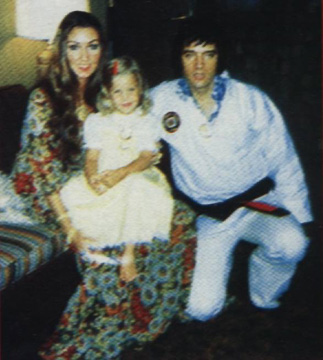
At left, Elvis is with Linda Thompson aboard a jet, probably at some time in 1973 or 1974. There are quite a few pictures from around this time that show Elvis wearing his one gi or another while out and about. The picture at right shows Elvis, in the same gi, with Linda with Lisa Marie, probably around her fifth birthday in February, 1973, soon after Elvis opened another month-long Las Vegas season.

From some date in 1973 or 1974, Elvis, Linda, and Elvis' gi together aboard a jet.

Celebrating Lisa Marie's fifth birthday in Elvis' suite at the Las Vegas Hilton on February 1, 1973. By this stage, all hopes of a reconciliation between Elvis and Priscilla were shot and they would finish divorce proceedings before year's end. It's interesting how Elvis' devotion to the martial arts -- perhaps only second to music (and perhaps his spiritual studies, many of which were complementary to martial arts philosophies) in the energy he devoted to it -- played so central a role in the breakup of his family. It was soon after this family get-together that Elvis (allegedly, I must stress) decided that "Mike Stone must die." Elvis was apoplectic about Stone -- not so much because the karate champ stole his wife away, which was insult enough, but that (as Priscilla related to Elvis to February 1) he'd suggested that Lisa Marie would be better off not being around Elvis and the off-kilter Las Vegas life. Elvis became enraged by the thought of this arrogant interloper denying him his daughter and -- so they say -- sent members of his entourage off to dig up contract killers who'd do the job for him and eventually got to the point where he looked as if he was going to take his own M-16 and do the job himself. After a couple or three days, so the story goes, Elvis calmed down and decided that maybe that course of action was a bit "heavy" for now.

Elvis and Muhammed Ali in the Las Vegas Hilton during Elvis' season there in January-February, 1973. This photo was supposedly taken on the same day as the one above. The two had a mutual respect and met more than once. Around this time, Elvis gave Ali a $10000 robe (which declared him the "People's Champion") but Ali lost the fight he wore it for and wouldn't wear it again. The robe looked a lot like one of Elvis' 1973 jumpsuits and was probably commissioned by Elvis to be made by Bill Belew, the man who designed and made all of Elvis' stage attire (starting with the black leather suit he wore for the 1968 TV Special) and most of his off-stage clothes.

Elvis picks a fight with Ali at some time during Elvis' February, 1973 engagement. Ali is wearing the custom robe that Elvis had commissioned.

Elvis posing with Kang Rhee outside his Las Vegas suite in February, 1973.
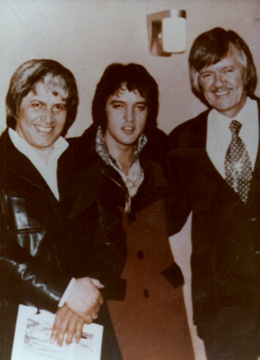
Elvis with Ed Parker (left) and his bass singer, JD Sumner, at the Las Vegas Hilton in Jnauary or February of 1973. Elvis is wearing one of his "Superfly" coats -- he really loved those kinds of clothes and the image that went along with it (actually quite consistent with the way he was in the '50s, even before he started singing, when he crossed the color barrier and began wearing flashy clothes usually favored by black musicians in Memphis...got him beaten up a lot, in those days). JD Sumner and his Stamps gospel quartet began backing Elvis in late 1971, after the Imperials left Elvis' show. Elvis and JD went way back, back to Elvis' teenage years when he used to attend all-night gospel concerts -- JD would sometimes sneak him in through backstage, Elvis being too poor to buy a ticket, and Elvis hung out with the gospel quartet singers (as he admitted on stage a few times in the 70s, he desperately wanted to be part of a gospel group, preferably a bass singer).
From Variety (2/6/73): "Presley lays on a helluva show. He struts and preens, exhibits his karate stances, muscular control and strength in his legs on deep bends and stretches, grinning at the salivating girlies piled row upon row at ringside...The dean of rock 'n' roll has learned his showmanship lessons well at the ripe age of 37. He grabs the males as well as females with powerful vocal thrusts...He may be merchandised beyond belief, yet possesses too much innate musicality to become the colonel's mechanized doll -- at least onstage."
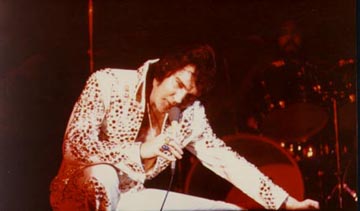
Pulling a split during the afternoon show of April 28 1973, in Spokane, WA.

At the afternoon show of April 29, 1973, Elvis shows the Seattle, WA, audience how low he can go.
From the San Diego Union (4/27/73): ""Elvis in Person" last night at the Sports Arena, the ever-living epitome of rock n' roll. A hunk-a-hunk-a burnin' love. Surly, Pouting. Dreamy. Romantic. Hip-swivelling. Pelvis-grinding.Husky. Smouldering."
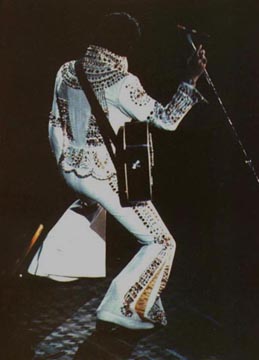
Dropping into a square horse stance at the microphone in Uniondale, NY, on June 22, 1973. Photo (possibly) by Phil Gelormine, who wrote the Billboard review below.

Elvis in a typical forward horse (aka "bow and arrow") stance as he faces Nassau Coliseum's crowd later in the same concert. Photo also probably by Phil Gelormine.
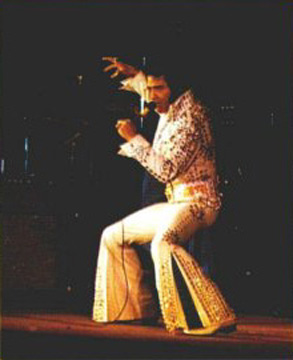
Elvis dropping to a square horse stance during the June 23, 1973 afternoon show at Uniondale, NY. I think he was doing "American Trilogy" when he struck this pose.

Elvis stretching in front of another huge crowd in Long Island's Nassau Coliseum (Uniondale, NY) on June 24, 1973, the last of four shows performed over a three-day stand in the June-July tour.
From the Melody Maker (6/30/73): "Presley's concerts -- and there were four of them over the weekend at Nassau Coliseum on Long Island -- have now become so formalised as to have attained the proportions of ritual."
From Billboard (7/14/73): "Maybe it's unfair to ask more of Elvis Presley than he's willing to offer lately in performance. The truth is, "The King" simply doesn't put out like he used to. The lean, savage tiger man of Las Vegas four years ago, who astounded even his severest critics with a renewed vitality following nine compromising years behind celluloid, has apparently been reduced to a tame, good-natured teddy bear. Now it's all charisma and little charatcer. Where RCA's Elvis once rock 'n' rolled, he's now content to strut 'n' stroll. While the man is a smooth, polished pro, in complete command of every second on stage, for some reason he's holding back. What excitement he does generate, like his dancing on "Blue Suede Shoes" or the karate fight finale of "Suspicious Minds", only serves as a reminder of what is he certainly capable of. Vocally, Elvis has never sounded better. His ability to reach for notes other singers wouldn't dare again confirms his continued reputation as one of music's finest interpreters...And what entertainer in the world can follow "How Great Thou Art" with "Hound Dog," as he did Sunday, and make both sound equally convincing."

An interesting pose from Elvis during his June, 1973 tour.


Two shots of Elvis stretching it out in Nashville, TN, on July 1, 1973. Although Elvis often recorded in RCA's Nashville Studio B, this was the only concert that he did there during the 70s. Elvis was never really accepted by the conservative Nashville Establishment, beginning with his harsh 1954 rejection by the Grand Ole Opry's talent scout, Jim Denny. In fact, it wasn't until recently that he was finally inducted into the Country Music Hall of Fame (years after some of the inductees who he'd originally inspired), though the Hall of Fame didn't mind making money off the people who'd come there to see his 'solid gold' Cadillac and other items that he'd donated to the hall while still alive. Basically, Nashville wasn't ready for Elvis and they did not deserve him.

Elvis gets his kicks on stage in Nashville.
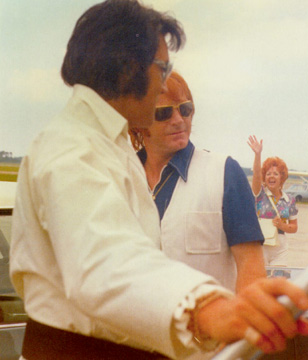
Elvis on tour somewhere in June, 1973, boarding his chartered jet (the Lisa Marie's debut was two years hence, along with a fleet of other jets spend-happy Elvis bought during 1975) on his way to another city and another stadium. He's wearing his karate gi and black belt.

Bodyguard Red West, a friend and sometime protector since high-school days, is right behind Elvis as he heads into the 'plane. Red and his cousin, Sonny, had already landed themselves and Elvis in hot water many times and the legal problems their violent behavior sparked were a prime reason why Elvis had the pair (and relative newcomer, kenpo practitioner Dave Hebler) fired in 1976 -- the firings were the caalyst that resulted in the sensationalist, exaggerated tell-all titled "Elvis -- What Happened," the "bodyguard book" that came out just before Elvis died (and for which Elvis had already seen galley proofs, disturbing him greatly, to say the very least). Red West is now pretty firmly ensconsed as a character actor and the most surprising thing about this hot-tempered, violent-prone man -- an almost stereotypical macho redneck in some ways -- is that he wrote some very good, sensitive songs for Elvis and for many other performers.

Another shot of Elvis getting aboard his chariot, possibly from the same day or the same tour.
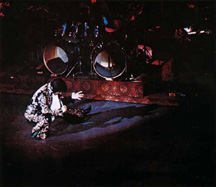

Elvis showing his moves to his Las Vegas audience, possibly during the midnight show of August 31, 1973. During that night's rendition of the sultry "Fever," for which the stage lights went down, Elvis joked that he had a good chance of getting lost up there in his black suit.

Elvis during his closing show of September 3, 1973. Elvis had made it through another month of twice-nightly (a couple of times a third show was added) shows but Vegas was rapidly paling on him and taking a toll on his health. Starting in January, 1974, Elvis began playing two-week stints in Vegas. The last show of Elvis' 1973 Summer Festival was a particularly crazy one, with Elvis in an infectiously hilarious mood. At one point, though, Elvis launched into a short tirade against the hotel management for firing one of his favorite cooks and then dedicated "Tiger Man" to the hotel's hierarchy. The Colonel was not amused, but the assembled fans -- including British fan club members who'd traveled en masse to catch the last few days of Elvis' engagement (many of them were shoddily treated by the hotel) -- applauded enthusiastically and it was obvious whose side they were on.
Text and layout protected by Copyright (© Shane Paterson, 2000-2002).
More...
Back to Elvis and the martial arts...